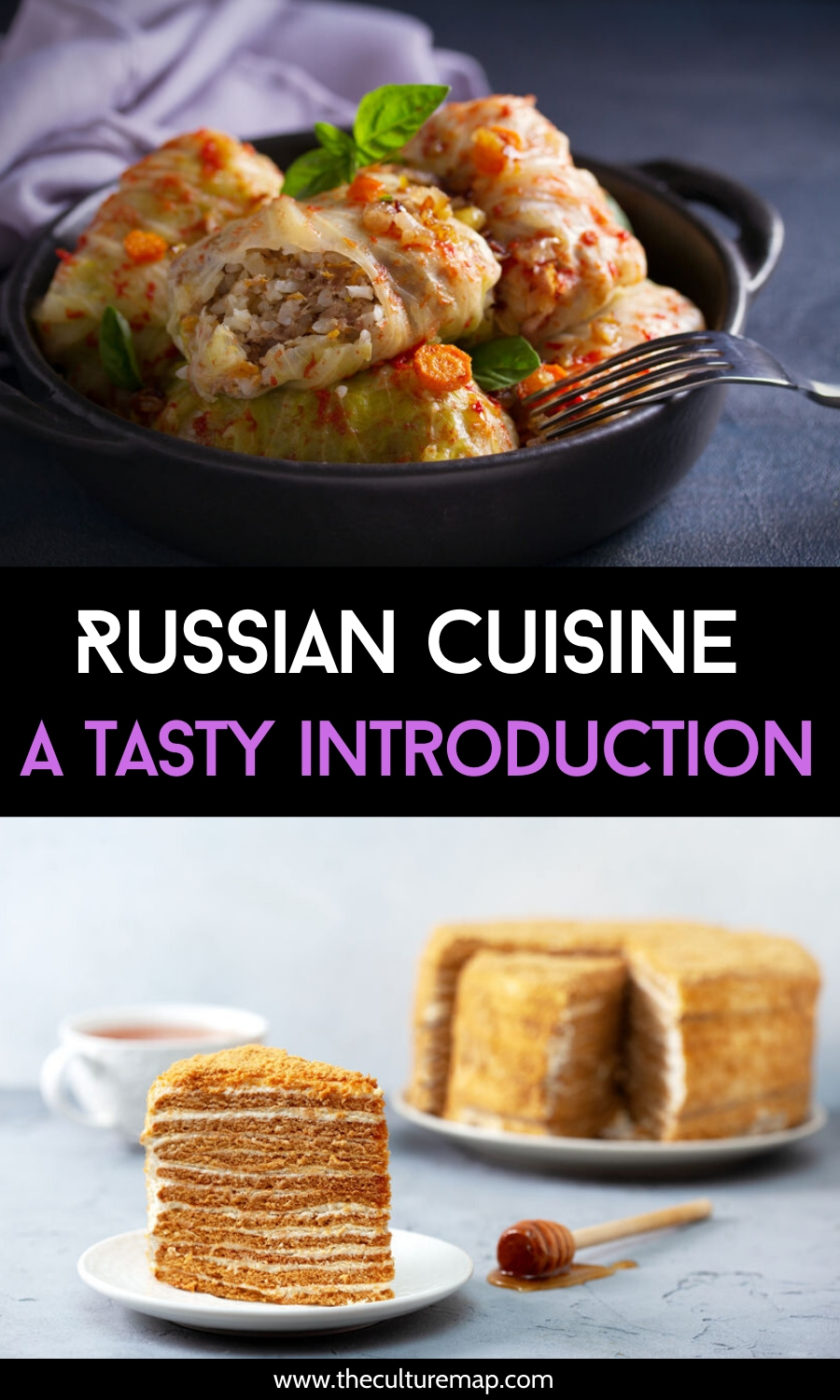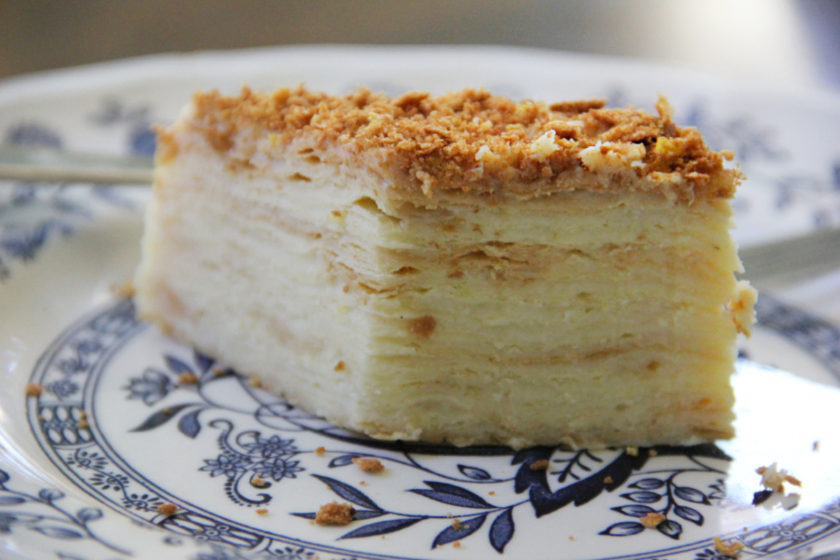
Contributor
Vassili now calls London home, but he has lived in Russia, France and the US. When he’s not travelling for work or pleasure, he’s feeding his greedy appetite in London.
While we are all partial to a crusty Italian pizza, fresh piece of Japanese salmon nigri or a buttery French croissant, how many of us have tried Eastern European food, in particular Russian food? Aside from Russia’s famous and ubiquitous exports of vodka and caviar, Russian cuisine is as varied and full of surprises as the country is vast and rich in history.
Here are my top ten picks among the savoury staples of Russian cuisine. As Russians say: Vkusno! Yummy!
Olivier Salad
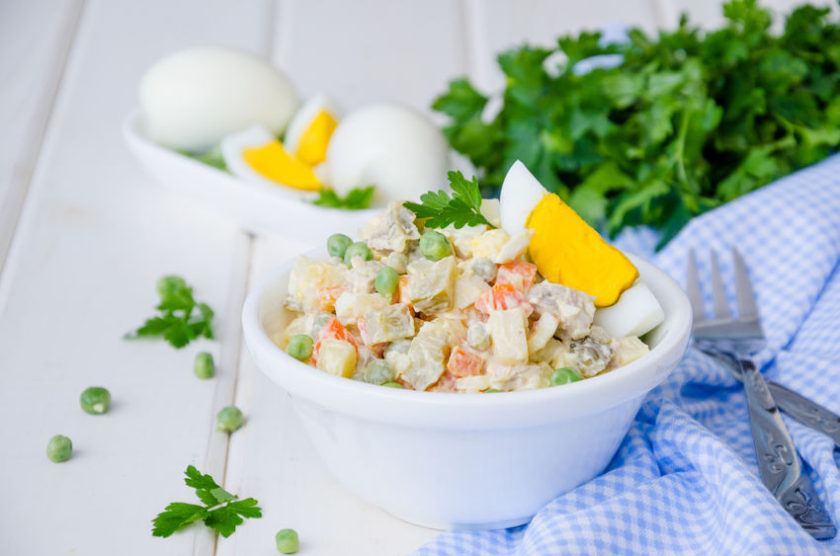
Often known outside of Russia as, well, Russian salad, the salad is called in Russia Olivier Salad after the name of its Belgian inventor, Lucien Olivier. Monsieur Olivier was one of the many ambitious émigrés from Western Europe who brought their talents to Moscow and St Petersburg in the 19th century in order to cater to the craving for all fine things European of Russian city-dwelling cognoscenti.
Olivier Salad is known to have been created in the 1860s at Monsieur Olivier’s Moscow restaurant The Hermitage and soon became the restaurant’s signature dish. While the original recipe was a closely guarded secret known to contain caviar, crayfish and smoked duck, the salad became so popular that it progressively turned into a staple dish of Russian food containing more widely available ingredients.
Today’s main version of Olivier Salad usually contains boiled potatoes, dill pickles, peas, eggs, carrots, and boiled beef, ham or chicken dressed with mayonnaise. There exist as many variations of the salad as Russian chefs. My personal favourite includes smoked salmon and salmon eggs (Russians obviously looove salmon). However, vegetables and especially mayonnaise, another thing Russians cannot get enough of, are always at the core of the salad’s recipe, testifying to its Belgian origin. It is a dish dear to all Russians traditionally served for New Year’s Eve and the most commonly used trick by Russian parents to make their kids eat vegetables (yummy mayonnaise…)!
Borscht Soup
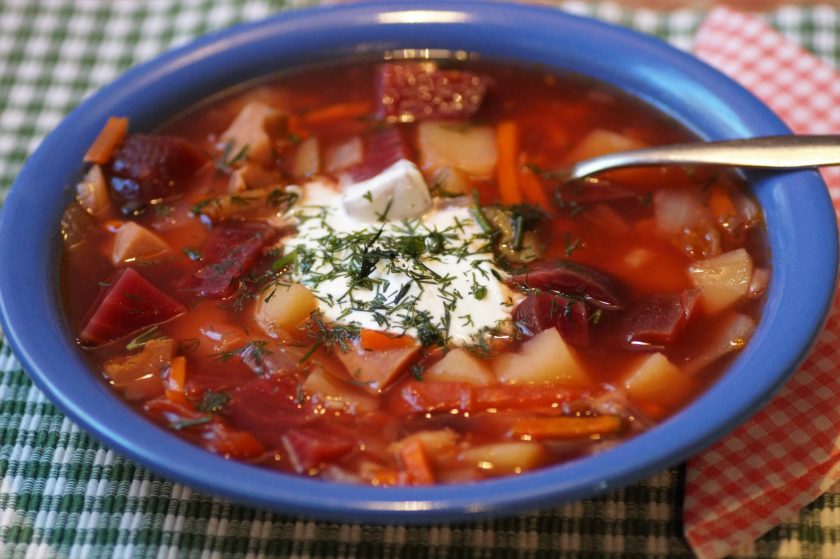
Aside from mayonnaise-infused salads, Russians love to eat soups all year round. The tasty Borscht is another staple of Russian cuisine, usually served warm in the winter but also cold in the summer. Originally from Ukraine, Borscht is eaten all over Eastern Europe and the Baltic States and there exists countless local and regional variations of the soup.
The recipe always contains beetroots as well as many other ingredients, among which carrots, cabbage, potatoes, onions, tomatoes and parsley together with a stock made out of beef, pork or a combination of both. The hearty soup is often accompanied with a touch of smetana and ukrop, sour cream and dill, two favourite ingredients of Russian cuisine.
Pelmeni
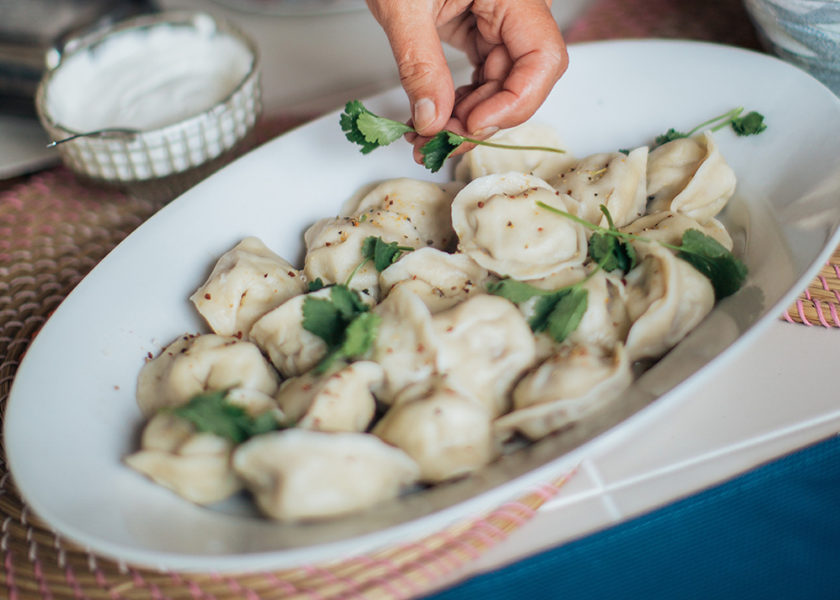
Russia is the world’s largest country, spanning from Europe to Asia, so it is only logical that Asian cuisine would influence Russian culinary traditions. Pelmeni, or Russian dumplings, is another staple of Russian cuisine. Thought to originate from Siberia, pelmeni are similar to Asian dumplings such as Mongolian bans and Chinese jiaozi and wonton.
The filling is usually made from minced meat and fish such as pork, lamb, beef, venison or salmon, cooked with pepper, onions and garlic. The stuffing is then enveloped in dough made from flour, water and eggs and boiled. It is served on its own or in a broth and eaten with sour cream or mayonnaise (of course). Frozen pelmeni are found in every store across Russia, constituting a dish of choice for students, bachelors and anyone wanting a tasty and quick meal.
Golubtsi
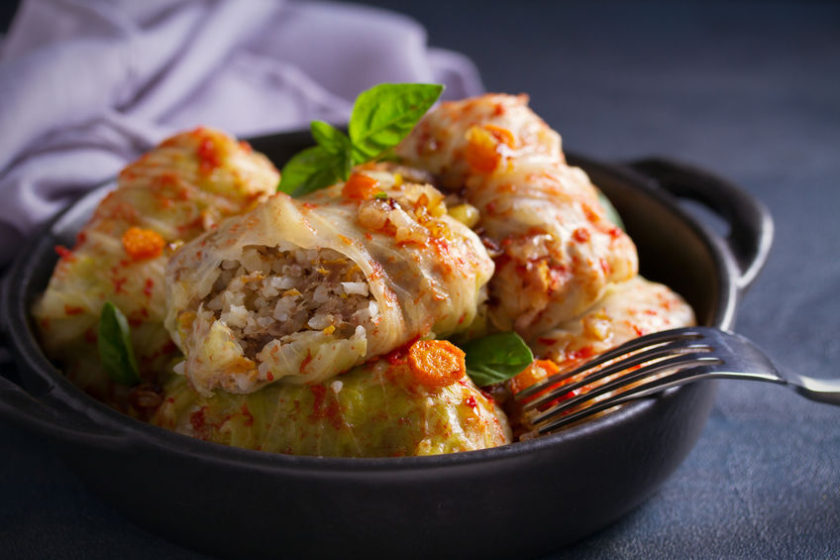
Another dish which can be found all over Central and Eastern Europe under various names and local recipes, Golubtsi or cabbage rolls were my Russian grandmother’s favourite recipe and one which she cooked to perfection. I still remember watching her prepare the stuffing as a kid while my mouth was slowly watering…
The cabbage is first boiled before being stuffed with a mixture of beef, pork, carrots, onions, fresh parsley and rice and then cooked in a tomato and sour cream sauce. Another simple dish to make but one that will leave you full and contented with a smile on your face, albeit slightly sleepy.
Pirozhki
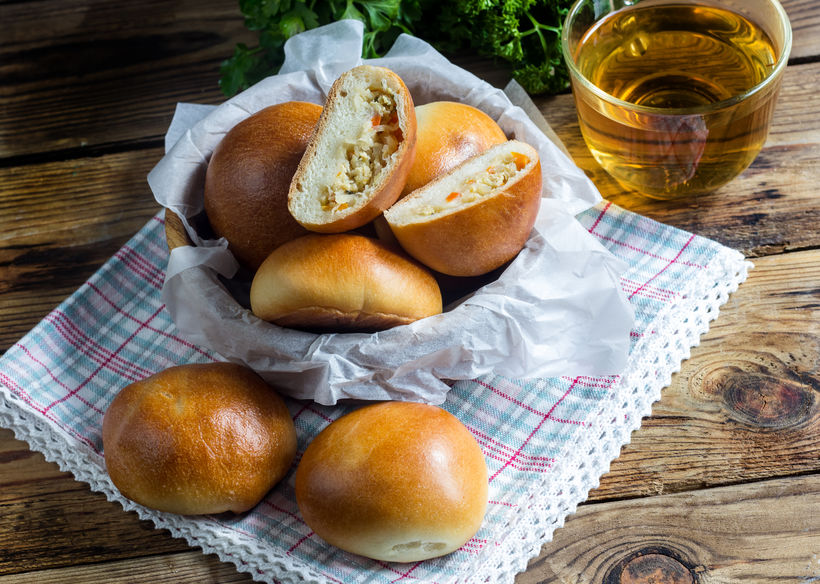
In addition to delicious and hearty main dishes, Russians love eating smaller dishes on their own, as starters or accompaniment. When the weather gets cold, the more food the better to get you through the winter.
Pirozhki are small stuffed baked pastries, similar to Indian samosas and other local pastry variations existing in most cultures. Russian pirozhki are baked or fried buns filled with as many fillings as one can think of. They are mostly eaten with mushroom, cabbage, meat, mashed potatoes or boiled eggs but also often come as desserts stuffed with apple, cherry or apricot jam. The perfect snack to eat during between meals or with a generous portion of borscht in the winter.
Blini
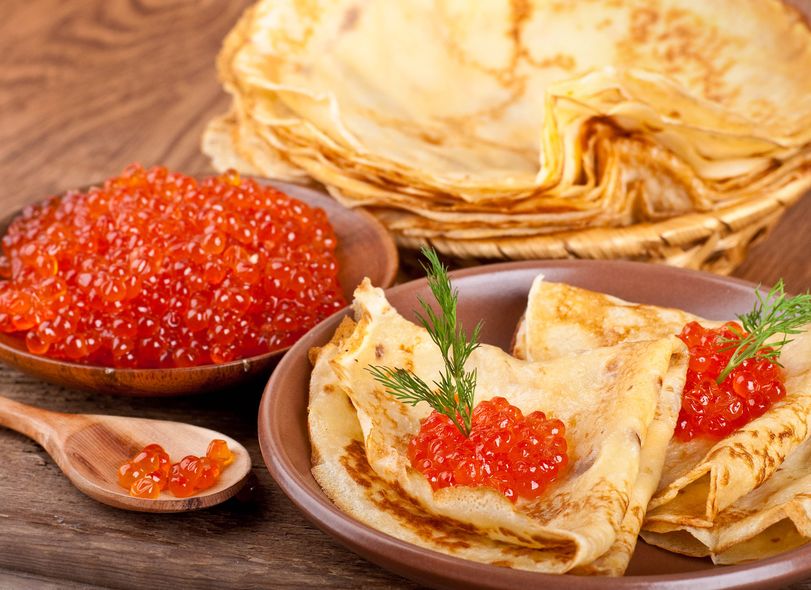
Similar to piroshki, the famous Russian blini are eaten in Russia a variety of different contexts as a treat or accompaniment to other dishes. Blini are pancakes traditionally made from wheat and sometimes buckwheat. Contrarily to the common understanding in the West of blini as small pancakes, in Russia blini are often large pancakes that are folded and served with a variety of garnishes such as smoked salmon, caviar, ham, cheese, jam, butter or sour cream.
Another specialty of my Russian babushka, my favourite version of blini is garnished with some butter and krasnaya ikra or red caviar made from salmon roe, a much more affordable alternative to the famous luxury black caviar made from sturgeon eggs.
Russian love their blini so much that they spend a whole day gorging on them with family and friends to celebrate the religious and folk holiday of Maslenitsa taking place in the spring on the last week before the Great Lent, the fasting season in the Eastern Orthodox Christian calendar. A great way to stock up on delicious food before fasting for a while.
For the anecdote, blini are so ubiquitous in Russian culture, that the singular form of the word blini – blin is one of Russia’s most common slang word, usually translated in English as Damn! Damn indeed. Blini are too good.
Medovik
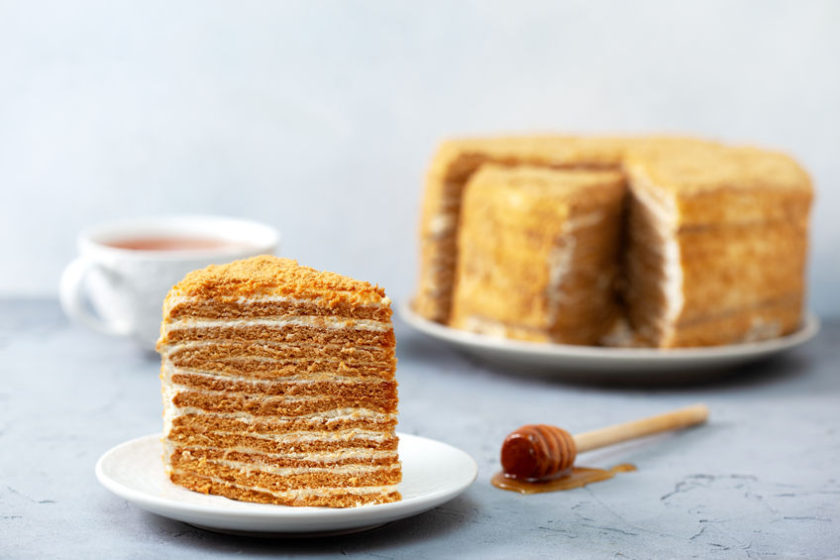
Finally, one cannot talk about Russian food without mentioning delicious Russian desserts. Not for the faint of heart, Russian cakes are often as big as the country and do not spare any cream and sugar. Medovik is probably my favourite Russian cake. Med in Russian means honey so you guessed it – Medovik is a honey cake.
Legend goes that in the 19th century, the wife of Russian Czar Emperor Alexander I, Empress Elizabeth could not stand honey and the thought of it drove her mad. One day, however, a young cook at the Russian court, unaware of the Empress’ dislike for honey, came up with a new cake with honey and thick layers of sour cream. The Empress tried it without knowing its content and surprisingly fell in love with it. Medovik has since become one of Russia’s favourite desserts. We can thank today both the cook and the Empress’ unawareness for this delicious treat.
Napoleon
Judging by the name, I am sure you can guess the Napoleon cake has a long history. The cake is another testament to the influence of French cuisine on traditional Russian food. Originally called mille-feuille, the cake was invented in France in the 18th century. The cake is made out of layers of puff pastry alternating with layers of pastry cream. Sounds yummy, doesn’t it? The main difference between the French mille-feuille (meaning literally in French thousand layers) is that the Russian version is often closer to having thousand layers than the French original. In Russia bigger is always better.
The cake is closely related to a French version of the French mille-feuille, also called Napoleon made with an almond-flavoured paste. However, the cake has been especially popular in Russia since the centenary celebration of the Russian victory over Napoleon Bonaparte in the war of 1812 when French troops tried unsuccessfully to invade Russia.
During the celebrations of 1912, triangular-shape pastries were sold resembling the bicorne, the traditional two-cornered hat worn by generals of the Napoleonic army. The cake’s many layers represented the French army and the pastry crumbs at the top symbolised the snow of Russia which played an important role in defeating the French troops. How fitting that Russians literally ended up eating Napoleon…
Kvass
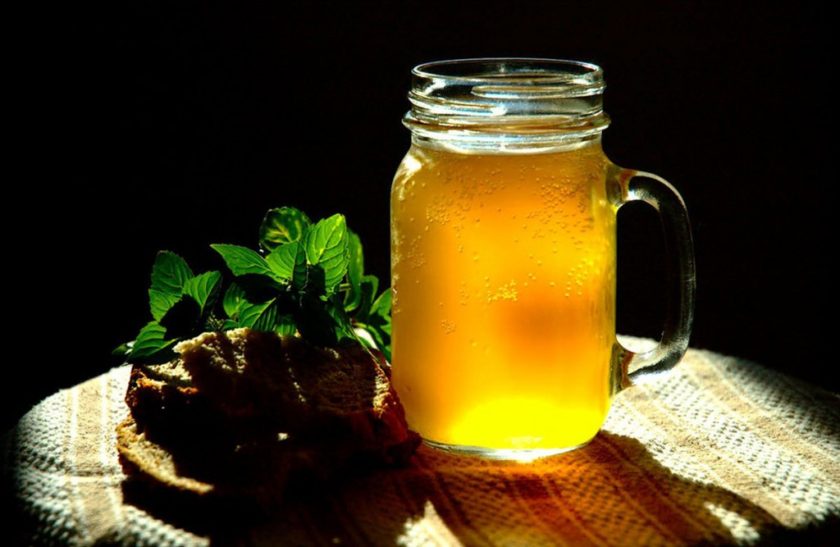
With all that delicious food, a refreshing beverage is in order to wash down a large Russian meal. Kvass is without doubt the most traditional Russian beverage, unofficially known as the ‘’Russian Coca-Cola’’. Coca-Cola even launched its own brand of Kvass in the USA called Krushka & Bochka Kvass. Kvass is made by the natural fermentation of bread, such as wheat, rye, or barley, and sometimes flavoured using fruit, raisings or berries collected in the early spring.
While Kvass is a non-alcoholic drink, it is comparable to some other ancient fermented grain beverages, including beer brewed from barley by the ancient Egyptians, the pombe or millet beer of Africa, the rice wines of Asia and the chicha made with corn or cassava by the natives of the Americas. Russians even make summertime soup with their local Coca-Cola called Okroshka, Botvinya and Tyurya! While the taste of Kvas is somewhat similar to beer and very far away from the seductively sweet Coca-Cola, one cannot have a complete experience of Russian cuisine without trying a refreshing glass of Kvass…
As we say in Russia, Priyatnogo Appetita! Bon Appétit!
